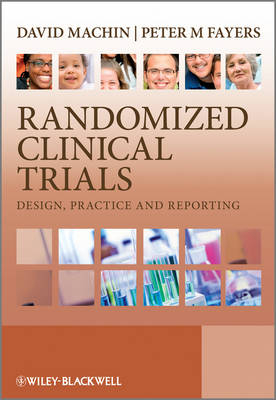
Randomized Clinical Trials – Design, Application and Reporting
John Wiley & Sons Inc (Hersteller)
978-0-470-68623-2 (ISBN)
- Keine Verlagsinformationen verfügbar
- Artikel merken
Using examples and case studies from industry, academia and research literature, Randomized Clinical Trials provides a detailed overview of the key issues involved in designing, conducting, analysing and reporting randomized clinical trials. It examines the methodology for conducting Phase III clinical trials, developing the protocols, the practice for capturing, measuring, and analysing the resulting clinical data and their subsequent reporting. Randomized clinical trials are the principal method for determining the relative efficacy and safety of alternative treatments, interventions or medical devices. They are conducted by groups comprising one or more of pharmaceutical and allied health-care organisations, academic institutions, and charity supported research groups. In many cases such trials provide the key evidence necessary for the regulatory approval of a new product for future patient use. Randomized Clinical Trials provides comprehensive coverage of such trials, ranging from elementary to advanced level.
Written by authors with considerable experience of clinical trials, Randomized Clinical Trials is an authoritative guide for clinicians, nurses, data managers and medical statisticians involved in clinical trials research and for health care professionals directly involved in patient care in a clinical trial context.
David Machin, Medical Statistics Group, School of Health and Related Sciences, University of Sheffield, UK and Children's Cancer and Leukaemia Group, University of Leicester, UK. Peter M Fayers, Department of Public Health, University of Aberdeen, UK and Faculty of Medicine, Norwegian University of Science and Technology, Trondheim, Norway.
Preface. 1 Introduction. 1.1 Introduction. 1.2 Some completed trials. 1.3 Choice of design. 1.4 Practical constraints. 1.5 Influencing clinical practice. 1.6 History. 1.7 How trials arise. 1.8 Ethical considerations. 1.9 Regulatory requirements. 1.10 Focus. 1.11 Further reading. 2 Design Features. 2.1 Introduction. 2.2 The research question. 2.3 Patient selection. 2.4 The consent process. 2.5 Choice of interventions. 2.6 Choice of design. 2.7 Assigning the interventions. 2.8 Making the assessments. 2.9 Analysis and reporting. 2.10 Technical details. 2.11 Guidelines. 2.12 Further reading. 3 The Trial Protocol. 3.1 Introduction. 3.2 Protocol abstract. 3.3 Protocol background. 3.4 Protocol research objectives. 3.5 Protocol design. 3.6 Protocol intervention details. 3.7 Protocol eligibility. 3.8 Protocol randomization. 3.9 Protocol assessment and data collection. 3.10 Protocol statistical considerations. 3.11 Protocol ethical issues. 3.12 Protocol organizational structure. 3.13 Protocol publication policy. 3.14 Protocol trial forms. 3.15 Protocol appendices. 3.16 Regulatory requirements. 3.17 Guidelines. 3.18 Protocols. 4 Measurement and Data Capture. 4.1 Introduction. 4.2 Measures and endpoints. 4.3 Making the observations. 4.4 Baseline measures. 4.5 Types of measures. 4.6 Data recording. 4.7 Technical notes. 4.8 Guidelines. 5 Randomization. 5.1 Introduction. 5.2 Rationale. 5.3 Mechanics. 5.4 Application. 5.5 Carrying out randomization. 5.6 Documentation. 5.7 Unacceptable methods. 5.8 Software. 5.9 Guidelines. 6 Trial Initiation. 6.1 Introduction. 6.2 Trial organization. 6.3 Data collection and processing. 6.4 Data monitoring. 6.5 Ethical and regulatory requirements. 6.6 Launching the trial. 6.7 Trial registries. 6.8 Guidelines. 7 Trial Conduct. 7.1 Introduction. 7.2 Regular feedback. 7.3 Publicity. 7.4 Data monitoring committees. 7.5 Protocol modifications. 7.6 Preparing the publication(s). 7.7 The next trial? 7.8 Protocols. 8 Basics of Analysis. 8.1 Introduction. 8.2 Confidence intervals. 8.3 Statistical tests. 8.4 Examples of analysis. 8.5 Other issues. 8.6 Practice. 8.7 Technical details. 9 Trial Size. 9.1 Introduction. 9.2 Significance level and power. 9.3 The fundamental equation. 9.4 Specific situations. 9.5 Practical considerations. 9.6 Further topics. 9.7 Other methods and software. 9.8 Guideline. 10 Reporting. 10.1 Introduction. 10.2 Publication guidelines. 10.3 Responsibilities. 10.4 Background. 10.5 Methods. 10.6 Findings. 10.7 When things go wrong. 10.8 Conclusions. 10.9 Guidelines. 11 Adaptations of the Basic Design. 11.1 Introduction. 11.2 Repeated measures. 11.3 Cluster-randomized trials. 11.4 Non-inferiority trials. 11.5 Guidelines. 12 Paired Designs. 12.1 Cross-over trials. 12.2 Split-mouth designs. 12.3 Paired organs. 13 More Than Two Interventions. 13.1 Introduction. 13.2 Unstructured comparisons. 13.3 Comparisons with placebo (or standard). 13.4 Dose response designs. 13.5 Factorial trials. 14 Further Topics. 14.1 Introduction. 14.2 Adaptive approaches. 14.3 Large simple trials. 14.4 Bayesian methods. 14.5 Zelen randomized-consent designs. 14.6 Systematic overviews. 14.7 Conclusion. Statistical Tables. Glossary. References. Index.
| Erscheint lt. Verlag | 16.5.2011 |
|---|---|
| Verlagsort | New York |
| Sprache | englisch |
| Maße | 152 x 229 mm |
| Gewicht | 666 g |
| Themenwelt | Medizin / Pharmazie ► Medizinische Fachgebiete ► Pharmakologie / Pharmakotherapie |
| ISBN-10 | 0-470-68623-5 / 0470686235 |
| ISBN-13 | 978-0-470-68623-2 / 9780470686232 |
| Zustand | Neuware |
| Haben Sie eine Frage zum Produkt? |
aus dem Bereich
